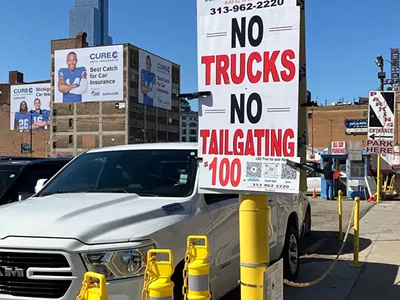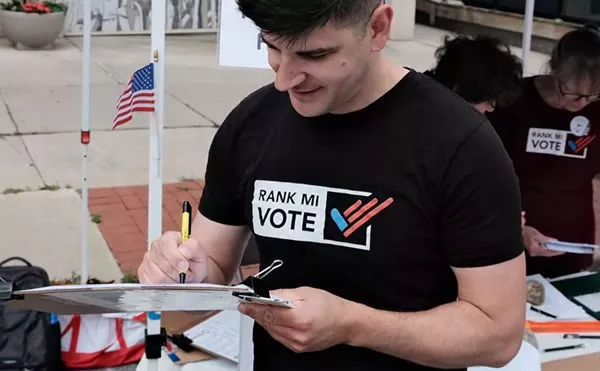Whistle-blower alleges corruption at Michigan Department of Corrections
A witness to numerous overdoses in state prisons accuses officials of turning a blind eye to collusion between officers and inmates in smuggling drugs


Audio By Carbonatix
[
{
"name": "GPT - Leaderboard - Inline - Content",
"component": "35519556",
"insertPoint": "5th",
"startingPoint": "3",
"requiredCountToDisplay": "3",
"maxInsertions": 100,
"adList": [
{
"adPreset": "LeaderboardInline"
}
]
}
]
One of prison’s worst-kept secrets is that almost anything sold outside the walls can be purchased inside, and a witness to countless inmate drug overdoses is calling for state and federal authorities to act.
Identified as “Abe,” the source spoke with Metro Times after approaching the Michigan State Police, Michigan Attorney General’s Office, FBI, DEA, Justice Department, and Senate Oversight Committee to offer proof of alleged drug trafficking and criminal conspiracy between Michigan Department of Corrections (MDOC) officers and prisoners; in three years of effort, Abe says no law enforcement or government agency has acted on extensive documentation that was provided, or accepted Abe’s offers to cooperate.
“I know the identities of the guilty prisoners and law enforcement officers at the MDOC, and outside the MDOC,” Abe says, “and I’d be willing to name them, as well as provide official evidence, if it were to spur an investigation.”
In order to report information and allegations evaluated as both credible and of public interest, Metro Times has elected to withhold several details about Abe, who spoke with the condition of anonymity, for the following investigation. Abe’s true name, gender, age, race, current employment status with the MDOC, and other potentially identifying data will not be published.
Abe’s list of alleged conspirators includes about 50 MDOC employees, specifically current and former prison guards, nurses and “non-custody” staff responsible for inmate support, volunteers, and 50 to 75 MDOC inmates. Abe says direct evidence and sworn testimony can be provided to prove:
- collusion between MDOC personnel and prisoners in smuggling fentanyl, heroin, cocaine, and other drugs
- extortion of MDOC inmates by MDOC staff
- MDOC administration efforts to suppress and prevent drug investigations
Others alleged to have smuggled what the MDOC categorizes as “substances” into prison have been issued probation, or have been otherwise “slapped on the wrist” for terminable or criminal offenses, Abe says. Abe also alleges that employees found in violation of MDOC policies are sometimes asked to resign to prevent documentation of a reason for termination, leaving the employees to seek positions in Indiana, Pennsylvania, or other state corrections departments.
MDOC is well aware of its trafficking issues.
“The Michigan Department of Corrections makes continuous efforts to stop the introduction of all contraband, including illicit drugs, from entering our correctional facilities,” spokesperson Jenni Riehle tells Metro Times in a statement.
About a dozen documents Abe shared with Metro Times range from what appear to be internal MDOC overdose incident reports and evidence summaries to communications between a Michigan State Police investigator and MDOC staff discussing confiscated heroin and methamphetamine. Using published reports and online profiles, Metro Times independently verified the names, positions, and departments represented by individuals who corresponded via email while addressing MDOC drug activity. (To prevent Abe’s identification through association with the individuals, their names and facilities are not printed in this report.)
In addition to law enforcement agencies, Abe shared correspondence with lawyers and elected officials. Rarely, responses came from those who were approached for help, Abe says, but the replies were followed by unmet promises.
Jack Wagner, co-founder and president of Michigan Justice Advocacy, is an exception who has become Abe’s ally. Wagner and several supporters formed his Ann Arbor nonprofit to press for legislation restoring the state’s “good time,” a former incentive system that lets inmates shave length from their prison sentences through exemplary behavior.
After launching Michigan Justice Advocacy in 2020, Wagner and his board began outreach that included distributing the MJA Weekly email newsletter to prisoners; eventually 3,500 subscribed as Wagner developed trust among the state’s incarcerated. When prisoners began telling him about overdoses at Saginaw Correctional and other MDOC facilities, Wagner grew concerned. A year ago he was introduced by telephone to Abe.
“Abe has seen colleagues fall prey to bringing drugs into the facility, having sexual relations, romantic relations [with prisoners],” says Wagner.
“I was, frankly, almost blown away by the darkness of the story,” he adds. “At first, I thought I was listening to some kind of fictional account, but then I thought, ‘Oh, my God! If this is going on at that facility, it’s rampant at other facilities.’”
“Abe sensitized me to this activity going on, so then when I’d get on the phone with a guy from Parnall or a guy from Cooper Street, I’d probe,” Wagner says, speaking of prisons in Jackson.
Wagner says he connected Abe with a former FBI agent, who found Abe’s claims credible.
“Most people with a conscience would say, ‘What the hell is going on? You can’t do this!’” adds Wagner. “But with enough people eating off the gravy train, a blind eye is turned.”
Speaking up about staff corruption, filing reports, and even following facility protocols that were deemed confidential only caused years of personal grief, Abe says: Mysteriously overlooked vacation requests and paycheck issues were minor, compared with multiple death threats from both prison guards and inmates. Despite feeling “tired, defeated,” Abe says justice and accountability remain the goal.
“I’m fine with all those risks,” Abe adds, “but I want it to be for something.”

‘Please call the warden’
Ironically, during 10 years of MDOC employment, Abe’s only sense of protection came from inmates. Having personally watched between 125 and 150 prisoners foam at the mouth, “turn blue,” and occasionally die in overdose incidents, Abe says even their peers grew fearful of drugs that came in from the street.
“I’ve had people throw up and puke on me, held people down so nurses could IV them,” Abe says.
Gradually, word leaked — or was deliberately spread — to some of the inmate population that Abe would report wrongdoing, no matter who committed it. A prisoner respected by gangs operating in MDOC facilities helped keep Abe alive, despite other instances of retaliation, Abe says.
There were varying levels of support from fellow staff at the facility where Abe worked, but as early as 2017 the proverbial writing was on the prison wall. Abe planned to earn and save as much salary as possible, and move on, “‘cause I knew this place was crooked.”
Abe’s path to a MDOC career began with a rocky upbringing in small Michigan towns where Abe bounced from family to family. The same drug plague that would fuel Abe’s crusade many years later is what split the youngster from a single, factory-worker mom, who was injured and became addicted to pain pills.
“She was a train wreck,” Abe remembers. “She couldn’t really raise me.”
A grandmother stepped in, offering stability and planting in her grandchild a seed about justice, law, and order, through her favorite television series, starring Chuck Norris.
“Walker, Texas Ranger was one of the only TV shows I watched regularly,” says Abe. “I always said one day I wanted to grow up and do what Walker, Texas Ranger could do.”
The years that led to adulthood included college and courses in law enforcement before Abe’s eventual hiring at an understaffed prison in the early 2000s. Abe immediately noticed “lax boundaries,” such as prisoners addressing corrections officers by first name. Familiarity between the guards and the guarded grew even more apparent as certain officers engaged in private conversation with inmates, while other officers displayed bias when issuing discipline, and certain prisoners could only be searched for contraband with a supervisor present, Abe says.
“There were numerous allegations that the officers, all the way up to the senior supervisors at the prison, were involved in the illegal activity,” adds Abe.
Instead of appreciation or, at least, acceptance of reports and inquiries about staff conduct, Abe says there were clap-backs in the form of reprimands, write-ups for insubordination, or investigations of Abe’s own performance.
“They would cool their jets for a couple weeks,” Abe says. “Then they’d be right back at me.”
Rhetorical questions, like “You wanna be able to afford your mortgage?” or “You got another way to pay that car note?” were common retorts from senior staff to those who openly challenged the status quo, Abe says.
Drug trade was at the root of defensiveness and hostility from peers and supervisors, Abe says. While gangs competed for business — including guards, counselors, resident unit managers, or volunteers who’d accept pay for cooperation — others worried about the results. As overdoses increased in 2017 and 2018, a prisoner who’d become a mentor to other inmates approached Abe, warning that death was imminent.
“Please call the warden,” he urged.
A package of drugs would be delivered soon, Abe was told.
“The prisoner started telling me specific things to watch, certain interactions between officers and prisoners, certain times of day,” says Abe. “I began observing… ‘You’re gonna see this officer walk over to this prisoner, whether the officer is assigned to that area or not,’ and lo and behold, that’s what happened.”
Abe didn’t contact the warden, but followed a chain of command, emailing an inspector. Told that the matter would be handled, Abe found it peculiar when higher-ups admonished that such tips never again be committed to writing. Abe concluded their goal was concealment, in the event of departmental inquiries or Freedom of Information Act records requests.
Eventually the prisoner was “rode out,” prison parlance for being transferred to another facility, but the inmate said Abe would be questioned about information the inmate had provided.
Abe was interrogated days later.
“So I’m like, ‘Goddamn!’ Everything the prisoner was saying was true,” Abe says.
Within a year or two Abe says “more and more prisoners” became sources, apparently recognizing Abe as trustworthy, but sometimes only hoping their tips would help disrupt rival drug operations. Abe’s trust in fellow MDOC staff and higher-ups dwindled by the day.
‘Whatever it is… it’s outrageous’
It was 7:58 a.m. on his brother’s birthday, Jan. 22, 2017, when Seth Zakora’s body was discovered lying in a C-Unit bunk at Lakeland Correctional Facility. His death from fentanyl was the third overdose at the Coldwater prison in 48 hours, since two of Zakora’s cellmates were hospitalized the same weekend, according to court records.
“At the time of Zakora’s death, illegal drugs were allegedly being smuggled into Lakeland in basketballs that were thrown over the facility’s fence. This scheme was allegedly orchestrated by defendant Jane Doe — an unidentified female corrections officer — and a prisoner with whom she was romantically involved,” reads a U.S. Sixth Circuit of Appeals ruling in the case filed by Brandy Zakora, Zakora’s mother.
“As alleged in the complaint,” reads the document, “drug smuggling by corrections officers is a chronic problem throughout the Michigan state prisons. The complaint recounts two incidents from 2016 when MDOC employees reported drug smuggling by corrections officers, but no investigation was undertaken.
“One of the employees allegedly sent his report to the [Michigan State Police], and the other emailed his concerns directly to defendant Heidi Washington, the director of the MDOC. Both of these employees were allegedly fired, only to be reinstated after instituting litigation and a civil-service hearing, respectively.”
Zakora’s death at age 21 became one of Michigan’s more visible overdose cases, due to Brandy Zakora’s lawsuit claiming MDOC and other state authorities knew about the prison drug plague, but failed to address it. Following appeals decisions, the U.S. Supreme Court rejected the complaint that Zakora’s Eighth Amendment right to protection from cruel and unusual punishment was violated, but a U.S. District Court is still considering it, says Chris Desmond, Brandy Zakora’s lawyer.
MDOC filed a motion to end the case, “in which they argued that no jury could rule in my client’s favor,” says Desmond, chief appellate attorney at Ven Johnson Law in Detroit.
“That motion remains pending as of now,” he adds. “There has been a recommendation by a magistrate judge assigned to the case that the motion be granted, but we have objected to that recommendation and are awaiting the judge’s ruling.”
Zakora’s mother represents a countless number of even non-incarcerated communities impacted by drug trafficking within MDOC.
“This has been a long and very difficult process for this family,” says Desmond.
Duane Williams, who was exonerated in 2024 after 11 years in Michigan prisons, never served at Lakeland Correctional, but says Zakora’s story is familiar.
“There’s overdoses every day, at damn-near every facility,” says Williams.
Wrongfully convicted in two deaths later ruled accidental, Williams has had several conversations with Abe through Williams’s work on behalf of metro Detroit-based Firefly Advocates, which supports prison reform.
Drugs, mostly heroin and marijuana, were commonplace from the time of his 2012 incarceration until his release, but the epidemic is “shocking, the way it is now,” Williams says. In particular, he names “drugs on paper,” concluding there were “more addicts in prison than I ever saw before” when he gained his freedom last year.
Paper drugs consist of potent synthetic chemicals printed or soaked into what appear to be ordinary documents, including books or magazines, not detectable as banned items. The paper is delivered to prisoners, torn into pieces, and smoked.
Williams says he has witnessed more erratic or aggressive behavior by inmates who were high from “paper” than from other substances: “Whatever it is about this stuff, it’s outrageous — whatever it is.”
Along with drones that fly above prison grounds to drop contraband, and inmates who use work details to receive and traffic drugs, one smuggling tactic involves paying the facility officer who manages mail, which can include paper contraband, Abe says. The guard simply removes from envelopes the drug contents — such as Suboxone strips, a medicine used to treat dependence on opioids — so they can’t be scanned, and delivers them later.
The MDOC drug plague has contributed to what Williams estimates as “a 200% increase” in ambulance service at MDOC facilities.
“I remember one night there were overdoses back to back. It kept us up all night,” says Williams. “They were giving CPR, running back and forth to the cells. Then, as soon as they pulled one guy out into the hallway, they were running back to get another one to give CPR.”
Williams served at Ionia’s Richard A. Handlon Correctional Facility and the former Michigan Reformatory, where he says the pandemic made it obvious in 2020 that MDOC staff played a role in smuggling.
“Let’s take it back to COVID,” says Williams. “There were no visitors, so there was no way anybody could get anything into prison.”
Due to social-distancing requirements, even “shakedowns” were suspended, meaning that staff and volunteers who still entered facilities weren’t subject to physical searches, he says.
Williams has watched a fellow inmate die of a drug overdose.
“Right now it’s a good chance that if you have a relative who was an addict when they went in,” he says, “they’re likely to still be an addict, or a worse addict, when they come home.”
Nicole Pacheco might have suffered a fate similar to what Williams describes, during her time at Huron Valley Correctional, a women’s MDOC prison. Though not a drug user, the self-described “alcoholic waitress,” convicted of drunk driving, learned that the Ypsilanti facility offered other vices.
“The main drug was Suboxone,” says Pacheco, adding that “regular paper soaked in THC” was sold and smoked.
A Huron Valley administrator called a particular inmate into the administrator’s office about once a month, Pacheco says, and like clockwork, the inmate would return with “big bundles” of Suboxone, available at $600 per strip.
“It was insane,” says Pacheco, who served from 2018 to 2021.
Suboxone amounts as small as “the tip of your pinky” sold for $15, she adds.
Like Williams, Pacheco says COVID revealed an obvious breach among MDOC staff, although she learned of media reports that drugs were being mailed undetected to prisoners.
“We were not getting our mail,” she says. “My daughter would send me pictures and they would give me the copies. I never got physical mail.”
She says, “It was absolute bullshit. These girls were overdosing,” adding that women “would fall out in the bathroom.”
But it was also during COVID cancellations of visitation by family and friends when individual corrections officers occasionally bent substance-use policy rules in favor of Huron Valley inmates.
“If you got caught with drugs you couldn’t even get a video visit,” Pacheco recalls. “A lot of women are sent there because of [crimes related to] addiction, and the officers knew we were struggling. No gym, no rec. You sat in that cell all day long. Instead of writing them up for overdosing — unless they had to call the ambulance and there was just no choice — if she was just slurring her words, they’d tell her to go lie down. They knew her grandmother was going to video-call on Saturday, because her grandmother called every Saturday.”
At the same time, Pacheco says she watched overdoses increase from about two a year before COVID, to one every few months. Having survived an atmosphere that threatened her own sobriety, today she works as a warranty operations manager and supports the work of Citizens for Prison Reform, a Lansing nonprofit.
As former prisoners, both Pacheco and Williams applaud Abe’s efforts to hold MDOC accountable. Williams says Abe’s allegations are credible, adding that it’s rare for anyone who has worked inside a prison to “be brave enough” to speak up.
“That’s why I really want somebody to help [Abe],” Williams says.

Whistle-blowing in the wind
Tattooed on Marvin White Bey’s right arm were a cross, flowers, and the words, “In memory of Lola Mae White.” The March 5 death of White Bey himself, at 59, in Kinross Correctional Facility is recorded among MDOC’s recently “discharged.” Two days later Kevin Dewayne Carter, 60, died at Kinross, which is located in the Upper Peninsula. Abe says Kinross prisoners have been hit hard by drug overdoses in 2025, but MDOC didn’t confirm the causes of White Bey’s or Carter’s deaths.
“The deaths of prisoners Marvin White and Kevin Carter have been referred to Michigan State Police and are currently under investigation,” MDOC’s spokesperson Riehle told Metro Times in a statement.
Michigan State Police confirmed that White Bey’s and Carter’s deaths were being investigated, but a spokesperson didn’t respond to Metro Times queries about whether MSP will investigate alleged MDOC staff drug trafficking. Similar Metro Times queries to Detroit’s FBI, DEA, U.S. Attorney for the Eastern District, and Michigan Attorney General received no response.
Danny Wimmer, press secretary for Attorney General Dana Nessel, said only, “This Department takes seriously all reports of criminal behavior.”
Prisoners who’ve been fortunate enough to survive overdoses at MDOC facilities have often contributed to a larger problem that impacts the state and its taxpayers: Ambulance service to such facilities as Kinross Correctional has helped generate massive debts owed to companies including Kinross EMS and other subcontractors that support MDOC.
“The state entered into a contract with Grand Prairie Healthcare Service, P.C. and made full payment for services — which included those performed by Grand Prairie, Wellpath, and their subcontractors — fulfilling the state’s contract obligations,” MDOC’s Riehle says. “As of April 22, 2024, the entities owed their subcontractors an estimated $35 million for services rendered during the time of the contract. Grand Prairie and Wellpath have failed to provide updated outstanding payment data, despite numerous requests from the state. The state filed a formal complaint against Grand Prairie and Wellpath on Sept. 13, 2024, seeking damages.”
Grand Prairie Healthcare and its management services organization, Wellpath LLC, provide various medical services to facilities and patients in 16 states. State Sen. Roger Hauck called for Michigan’s attorney general and auditor general to formally investigate MDOC’s medical- and rescue-related expenses.
“In February, Wellpath and Grand Prairie requested a termination of their contract, and the state agreed to let them walk away, despite their failure to address the issue of unpaid bills to health care providers,” Hauck said last year. “Rather than ensuring these outstanding payments were resolved, the state transitioned the contract to VitalCore Health Strategies, leaving many providers in a precarious position with no clear path to recovering what they’re owed.”
Abe adds that even documentation of the causes for ambulance service factors into the overdose problem. “Words such as ‘minor assault,’ ‘unresponsive prisoner,’ ‘undiagnosed medical reason,’ ‘possible influence of substance’ are used when it is clear something worse occurred,” Abe says. “That way, if lawyers or the courts request records for overdoses — without citing these words, or any combination of the words used — it will help hide how bad the epidemic is. MDOC staff are sometimes also ordered to not log medical runs at all. I have MDOC staff that will testify to this, and have been ordered to do this.”
MDOC prisons reported a combined 269 overdoses in 2023, but Abe and others suspect the number was likely much greater. Other MDOC data reflected “smuggling” that included drugs, weapons, or unspecified contraband, with individual facilities citing a range from no incidents in 2023 to as many as 22 incidents.
Lois Pullano, executive director of Citizens for Prison Reform, says smuggling is a concern not only related to health and safety, but its impact on families. Whether through MDOC staff or outsiders, drugs brought into facilities add to “tickets,” or violations, that result in policy restrictions of time prisoners spend with loved ones.
“We see individuals who don’t show up for their ‘med line’ [where doctor-prescribed drugs are given], and that’s a ticket,” Pullano says. “So there’s a lot of subjectivity to this.
“Yes, some of those tickets are written for hard drugs. Our belief is that families on the outside should not be punished and lose their visitation rights if the tickets did not occur during a visit.”
Substance abuse-related visit restrictions in 2024 totaled 1,633, an increase of about 400 from the previous year, according to the MDOC.
“There is no one reporting the actual number of visitors who were charged with bringing in drugs,” adds Pullano. “We would have expected it because they’re reporting a ‘visitor-related’ category in their critical incident report, so our question is: How many contractors and employees have been charged with smuggling illicit substances?”
While Pullano says she recognizes that smuggling attempts do occur with the participation of family and friends of inmates, there’s a need to “look at the entire picture.”
“We believe that everyone going to body scanners — contractors, employees, and volunteers — that should eliminate a lot of the issues that we have.”
Volunteers — non-MDOC personnel who visit prisons to support cultural, educational, or spiritual programming — have also been occasional drug sources, Abe says. Prayer beads, prayer rugs, and similar items have concealed contraband.
“Officers are less likely to search those too thoroughly, because they don’t want a religious discrimination lawsuit,” Abe says.
While Abe says about $5,000 of personal funds have gone toward expenses like legal consultation, travel, and photocopies, in the campaign to prosecute MDOC’s lawbreakers, Abe has rejected prisoner offers totaling about a half-million dollars.
“You could be driving around in a Lamborghini,” said one inmate. “Think of the attention you’d get.”
Abe says the bribery attempts appeared to be without pretense, particularly when colleagues “who never had money in their life” began taking exotic trips or adding costly square footage to their homes.
Wagner, Abe’s Michigan Justice Advocacy supporter, says Abe’s “concern over the drug-related overdose deaths is not fabricated or exaggerated, as I continue to receive similar reports from others, including several from the incarcerated population at various facilities around the state.”
Abe may be contacted via the Michigan Justice Advocacy website, mijustice.org, by law enforcement or government officials interested in pursuing an investigation, Wagner says. He’s hopeful that Abe’s crusade for justice won’t be in vain.
“It’s disappointing how few people get involved,” adds Wagner, “versus how many people say they want to be involved.”








